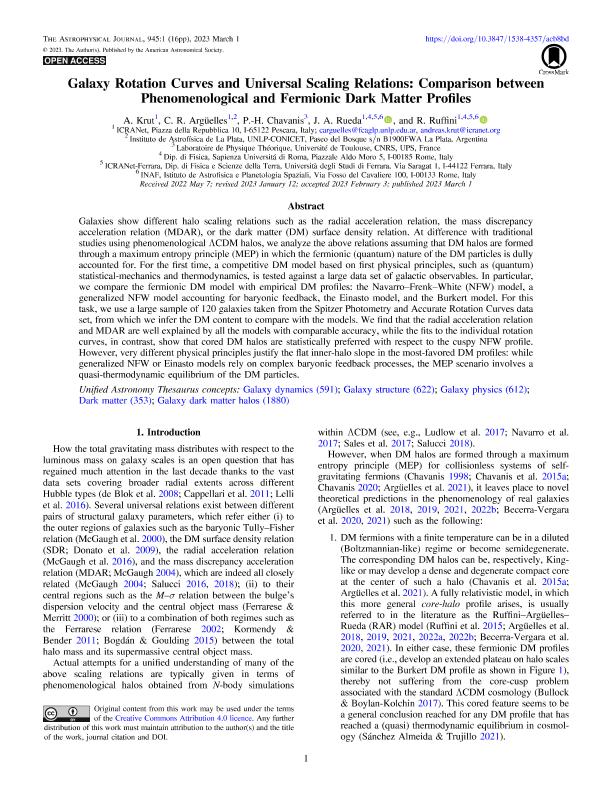Artículo
Galaxy Rotation Curves and Universal Scaling Relations: Comparison between Phenomenological and Fermionic Dark Matter Profiles
Fecha de publicación:
03/2023
Editorial:
IOP Publishing
Revista:
Astrophysical Journal
ISSN:
0004-637X
Idioma:
Inglés
Tipo de recurso:
Artículo publicado
Clasificación temática:
Resumen
Galaxies show different halo scaling relations such as the radial acceleration relation, the mass discrepancy acceleration relation (MDAR), or the dark matter (DM) surface density relation. At difference with traditional studies using phenomenological ΛCDM halos, we analyze the above relations assuming that DM halos are formed through a maximum entropy principle (MEP) in which the fermionic (quantum) nature of the DM particles is dully accounted for. For the first time, a competitive DM model based on first physical principles, such as (quantum) statistical-mechanics and thermodynamics, is tested against a large data set of galactic observables. In particular, we compare the fermionic DM model with empirical DM profiles: the Navarro-Frenk-White (NFW) model, a generalized NFW model accounting for baryonic feedback, the Einasto model, and the Burkert model. For this task, we use a large sample of 120 galaxies taken from the Spitzer Photometry and Accurate Rotation Curves data set, from which we infer the DM content to compare with the models. We find that the radial acceleration relation and MDAR are well explained by all the models with comparable accuracy, while the fits to the individual rotation curves, in contrast, show that cored DM halos are statistically preferred with respect to the cuspy NFW profile. However, very different physical principles justify the flat inner-halo slope in the most-favored DM profiles: while generalized NFW or Einasto models rely on complex baryonic feedback processes, the MEP scenario involves a quasi-thermodynamic equilibrium of the DM particles.
Palabras clave:
GALAXY DYNAMICS
,
GALAXY STRUCTURE
,
GALAXY PHYSICS
,
DARK MATTER
Archivos asociados
Licencia
Identificadores
Colecciones
Articulos(IALP)
Articulos de INST.DE ASTROFISICA LA PLATA
Articulos de INST.DE ASTROFISICA LA PLATA
Citación
Krut, A.; Argüelles, Carlos Raúl; Chavanis, P. H.; Rueda, J. A.; Ruffini, R.; Galaxy Rotation Curves and Universal Scaling Relations: Comparison between Phenomenological and Fermionic Dark Matter Profiles; IOP Publishing; Astrophysical Journal; 945; 1; 3-2023; 1-16
Compartir
Altmétricas




